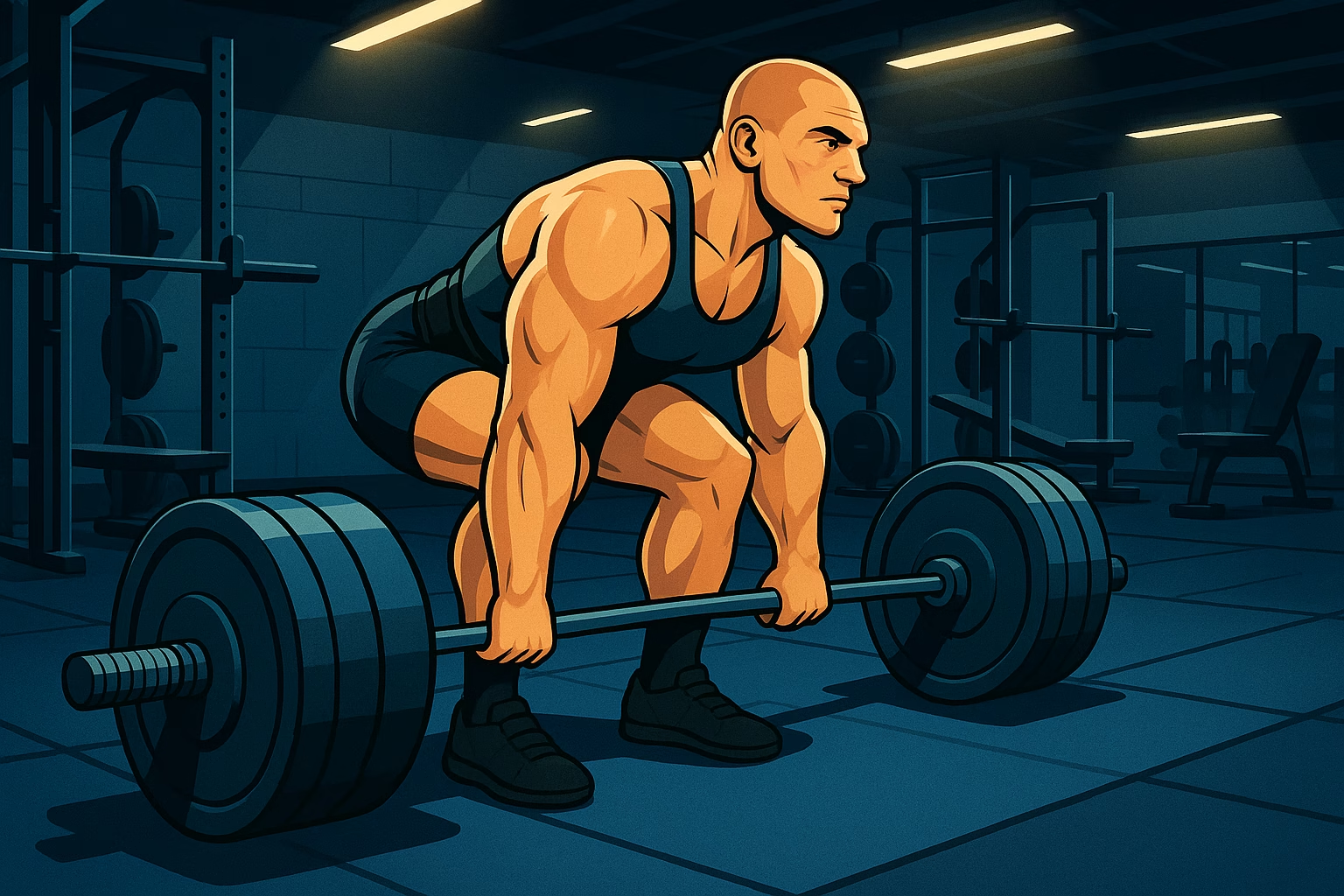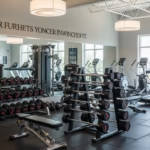Stay strong, stay safe. Master injury prevention and keep lifting for life.
The Big 3 Injury Zones
- Lower Back (40% of powerlifting injuries) – Most serious, often preventable
- Shoulders (25% of cases) – Usually from poor bench press form
- Knees (20% of cases) – Often due to squat technique issues
The 7 Most Common Powerlifting Injuries (And What Causes Them)
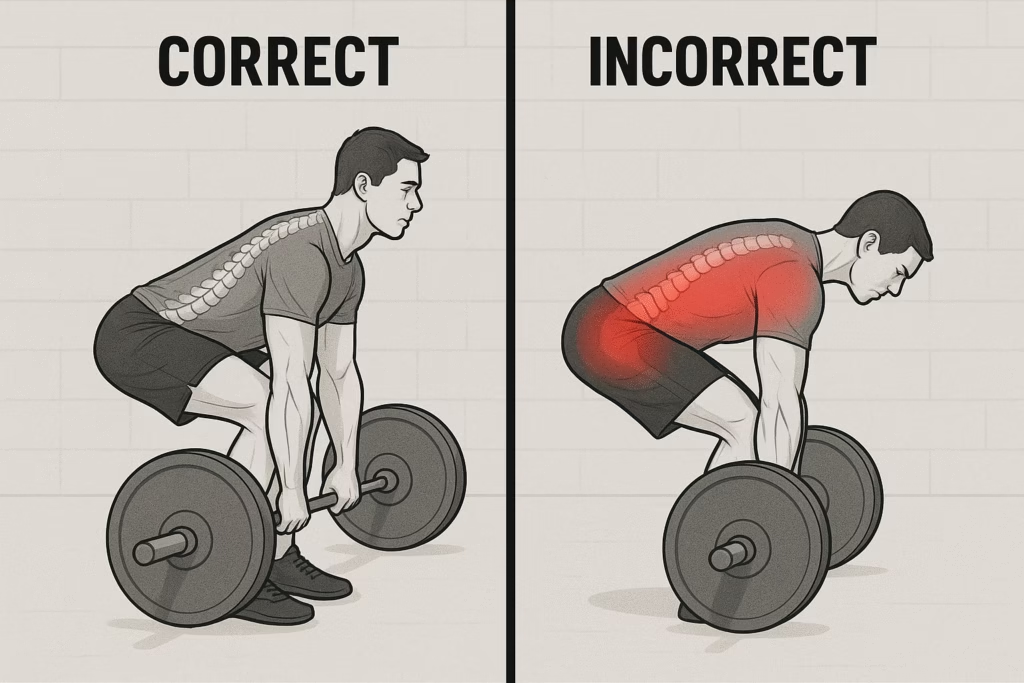
1. Lower Back Strain and Herniated Discs
The Problem: Your lower back takes a beating in powerlifting, especially during deadlifts and squats. When form breaks down or you lift beyond your capacity, the lumbar spine compensates in dangerous ways.
Why it happens:
- Rounded spine during deadlifts (flexion under load)
- Hip shift during heavy squats
- Lifting with cold muscles
- Ego lifting – adding weight before mastering technique
- Poor core stability and glute activation
Real-world example: You’re attempting a new deadlift PR. Your hips shoot up first, your back rounds, and you feel a sharp pain in your L4-L5 area. This classic “stripper deadlift” form is injury waiting to happen.
Prevention strategies:
- Master the hip hinge pattern with bodyweight first
- Strengthen your posterior chain with Romanian deadlifts
- Practice bracing techniques – imagine someone’s about to punch your stomach
- Use progressive overload – add only 2.5-5 lbs per week maximum
- Film your lifts from the side to check for spine neutrality
2. Shoulder Impingement and Rotator Cuff Injuries
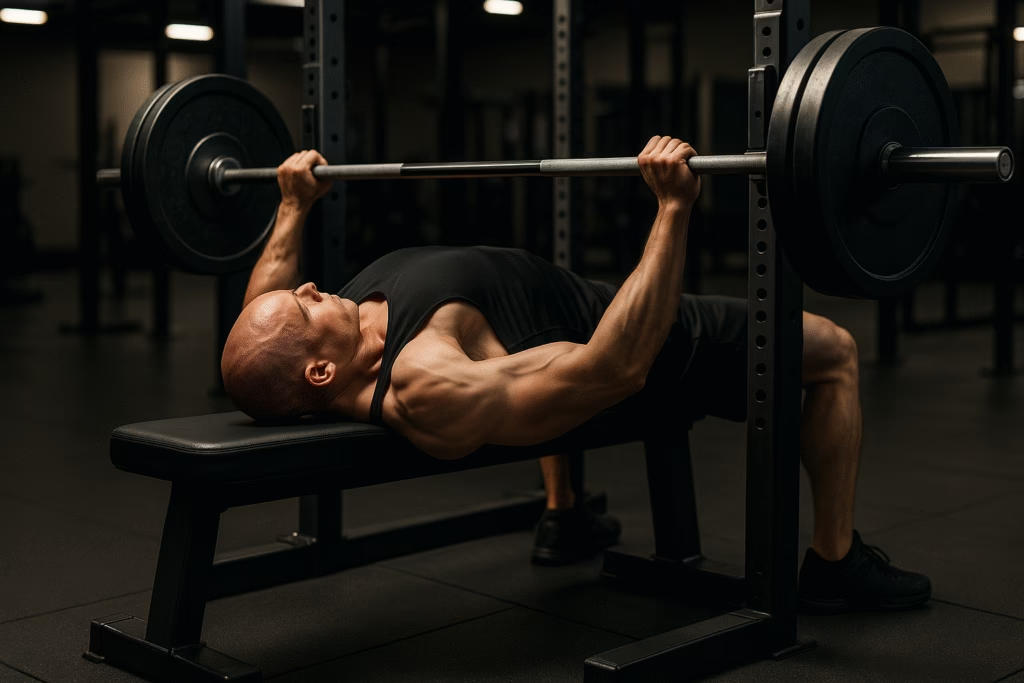
The Problem: Your shoulders weren’t designed to handle heavy loads in compromised positions. Poor bench press setup and overhead movements can create painful impingement.
Why it happens:
- Internal rotation during bench press
- Lack of shoulder blade retraction
- Poor thoracic spine mobility
- Muscle imbalances between chest and rear delts
- Overhead pressing with limited shoulder mobility
The anatomy lesson: Your rotator cuff consists of four small muscles that stabilize your shoulder joint. When larger muscles (pecs, delts) overpower these stabilizers, injury occurs.
Prevention tactics:
- Retract and depress shoulder blades before every bench press
- Include rear delt work 2:1 ratio to chest work
- Perform band pull-aparts daily (100+ reps)
- Address thoracic spine stiffness with foam rolling
- Use a closer grip if you have long arms
3. Knee Pain and Patellar Tendonitis
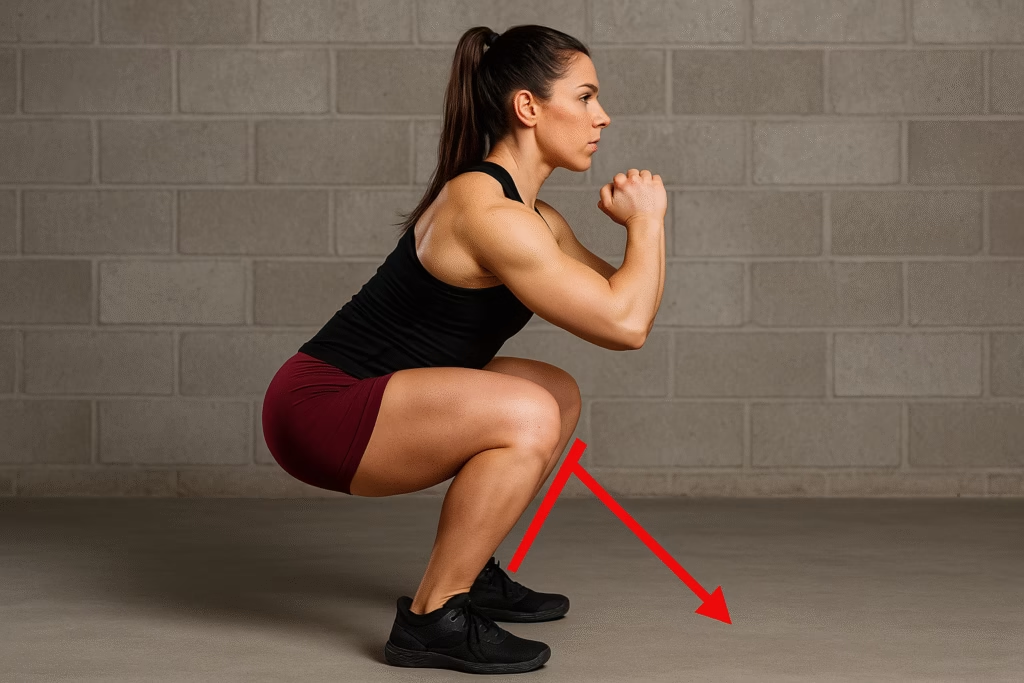
The Problem: Your knees are caught between your hips and ankles. When either joint lacks mobility or stability, your knees pay the price during squats.
Common presentations:
- Sharp pain below the kneecap (patellar tendonitis)
- Aching on the inside of the knee (valgus stress)
- Clicking or grinding sounds during movement
Root causes:
- Ankle stiffness forcing knees forward
- Weak glutes allowing knee valgus (knees caving in)
- Hip flexor tightness limiting squat depth
- Training through pain instead of addressing movement quality
The squat assessment: Can you perform a bodyweight squat with your heels down and knees tracking over your toes? If not, you’re not ready for loaded squats.
4. Bicep Tears During Deadlifts
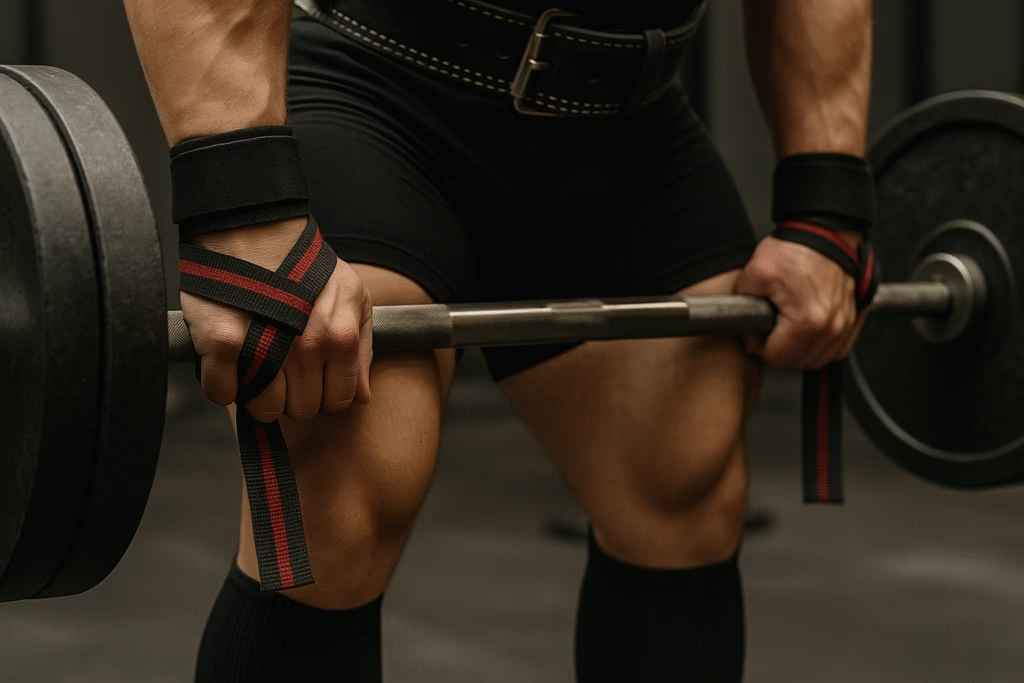
The Problem: Mixed grip deadlifts put your supinated (palm up) arm at risk for bicep tears, especially when fatigue sets in and form deteriorates.
The mechanism: Your bicep is trying to flex (bend) your elbow while you’re pulling the bar up. This opposing force can cause the bicep tendon to rupture, often with an audible “pop.”
High-risk factors:
- Using mixed grip on warm-up sets
- Jerky, explosive pulling off the floor
- Pre-existing bicep tendon issues
- Pulling with bent elbows instead of straight arms
Smart alternatives:
- Use lifting straps for heavy pulls
- Switch to hook grip or alternate grip weekly
- Keep arms completely straight during pulls
- Strengthen biceps eccentrically with slow negatives
5. Wrist and Elbow Tendonitis
The Problem: Repetitive gripping and wrist positioning under load can create inflammatory conditions in your forearms and elbows.
Tennis elbow vs. Golfer’s elbow:
- Tennis elbow (lateral epicondylitis): Pain on outside of elbow from gripping
- Golfer’s elbow (medial epicondylitis): Pain on inside of elbow from wrist flexion
Contributing factors:
- Death grip on the barbell
- Poor wrist position during bench press
- Inadequate grip strength for the loads lifted
- Overuse without adequate recovery
6. Hip Flexor Strains
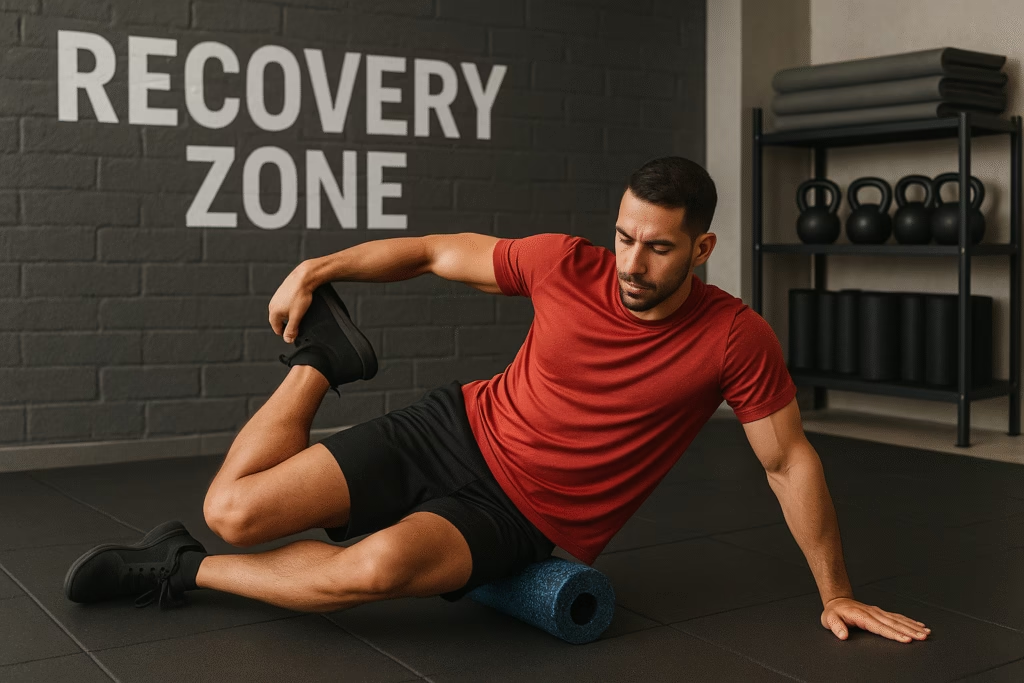
The Problem: Tight hip flexors from sitting all day, then asking them to stabilize during heavy squats, creates a recipe for strain.
When it happens: Usually during the bottom of a squat when your hip flexors are stretched and trying to contract simultaneously.
Prevention focus:
- Daily hip flexor stretching (couch stretch is gold)
- Strengthen hip flexors in lengthened positions
- Improve squat mobility gradually
- Address anterior pelvic tilt through core strengthening
7. Neck and Cervical Spine Issues
The Problem: Looking up during deadlifts or excessive neck extension during bench press can stress your cervical spine.
Simple fixes:
- Keep neutral neck position during all lifts
- Look straight ahead, not up, during deadlifts
- Don’t crane your neck to see the bar during bench press
The Ultimate Injury Prevention Protocol
Phase 1: Pre-Workout (15 minutes)
Dynamic warm-up sequence:
- 5 minutes light cardio (rowing or bike)
- Cat-cow stretches (10 reps)
- Hip circles (10 each direction)
- Arm circles and band pull-aparts (20 reps)
- Bodyweight squats (10 reps, focus on form)
- Glute bridges (15 reps)
- Push-ups or wall slides (10 reps)
Movement-specific preparation:
- Before squatting: Goblet squats, 90/90 hip stretch
- Before benching: Band pull-aparts, shoulder dislocations
- Before deadlifting: Hip hinges, glute activation
Phase 2: Training Smart
The 3-2-1 Rule for progression:
- 3 perfect reps before adding weight
- 2 weeks minimum at new weight
- 1 deload week every 4-6 weeks
Form checkpoints:
- Film yourself monthly from multiple angles
- Get coaching at least quarterly
- Use RPE (Rate of Perceived Exertion) instead of always maxing out
- Stop sets when form deteriorates, not when you physically can’t lift
Load management principles:
- Increase weight by 2.5-5 lbs maximum per week
- Use fractional plates (1.25 lb plates are your friend)
- Have honest conversations with yourself about readiness
- Track sleep, stress, and recovery metrics
Phase 3: Recovery and Maintenance
Daily non-negotiables:
- 10 minutes mobility work
- 7-9 hours quality sleep
- Adequate protein intake (0.8-1g per lb bodyweight)
- Stress management techniques
Weekly requirements:
- At least one complete rest day
- 2-3 dedicated mobility/flexibility sessions
- Soft tissue work (massage, foam rolling)
- Movement quality assessment
Troubleshooting Common Problems
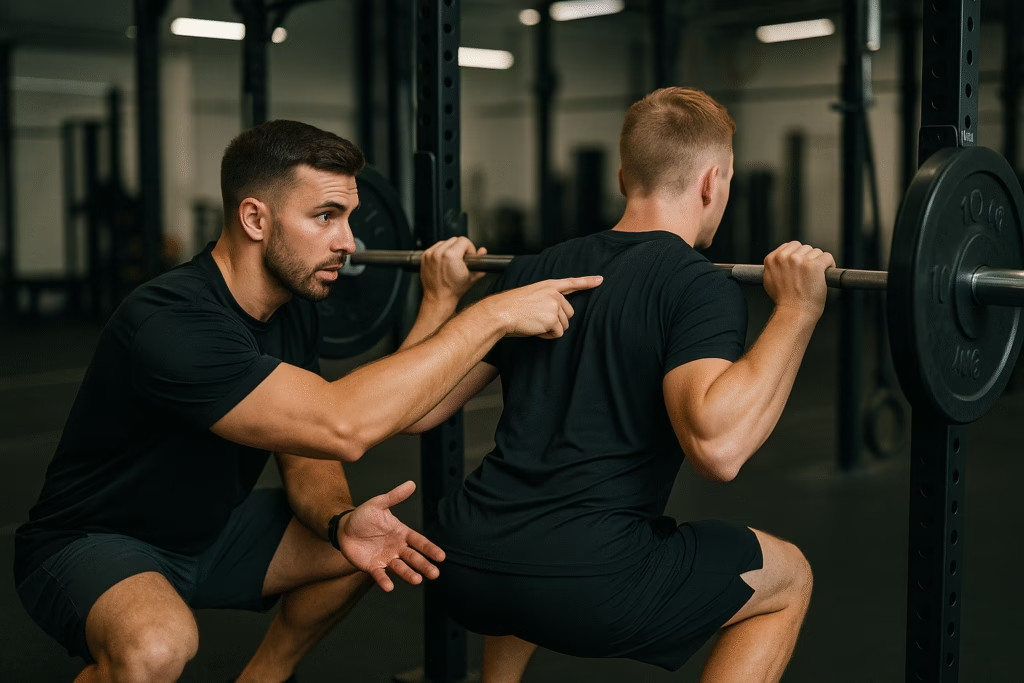
“My knees hurt during squats”
Immediate fixes:
- Check ankle mobility – can you squat with heels elevated?
- Assess glute strength – do 20 clamshells feel challenging?
- Examine foot position – try wider stance, toes out 15-30 degrees
- Address hip flexor tightness with couch stretch
Longer-term solutions:
- Strengthen glutes with hip thrusts 2x per week
- Improve ankle mobility daily
- Practice goblet squats focusing on knee tracking
- Consider temporary heel elevation during squats
“My back hurts after deadlifts”
Form analysis:
- Are your hips shooting up first? (Work on glute strength)
- Is your spine rounding? (Improve thoracic mobility)
- Are you hyperextending at the top? (Learn proper lockout)
- Is the bar drifting away from your body? (Lat engagement)
Corrective exercises:
- Romanian deadlifts for hip hinge pattern
- Planks and dead bugs for core stability
- Face pulls for upper back strength
- Hip flexor stretches for better positioning
“My shoulders hurt during bench press”
Setup checklist:
- Shoulder blades pinched together and down
- Slight arch in lower back (not excessive)
- Bar touches chest at nipple line or slightly below
- Elbows at 45-degree angle, not flared wide
Mobility work:
- Doorway chest stretches
- Thoracic spine extensions over foam roller
- Sleeper stretches for internal rotation
- Band pull-aparts throughout the day
Red Flags: When to Stop and Seek Help
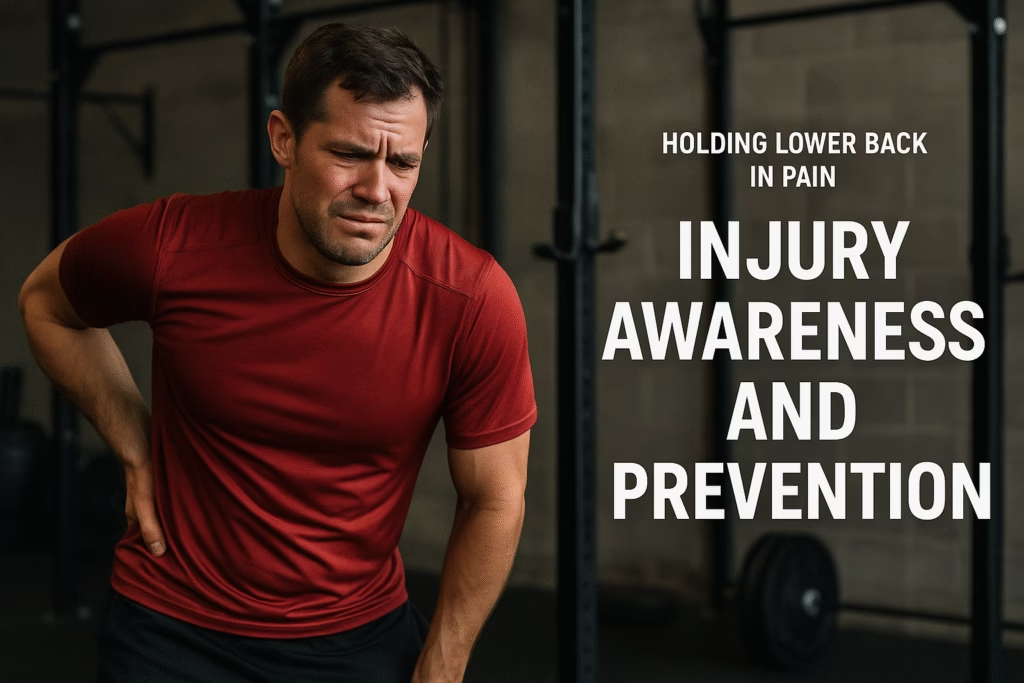
Stop immediately if you experience:
- Sharp, shooting pain that doesn’t subside
- Numbness or tingling in extremities
- Loss of strength or range of motion
- Pain that worsens with movement
- Any “popping” or “tearing” sensation
See a healthcare professional for:
- Pain persisting more than 3-5 days
- Recurring injuries in the same area
- Decreased performance despite adequate recovery
- Movement patterns that feel “off” or unstable
- Any concerns about serious injury
Find a qualified sports medicine professional who:
- Understands powerlifting demands
- Focuses on movement quality, not just pain relief
- Provides exercise-based solutions
- Has experience with strength athletes
Advanced Prevention Strategies
Periodization for Injury Prevention
Linear periodization example:
- Weeks 1-4: Higher volume, moderate intensity (70-80% 1RM)
- Weeks 5-8: Moderate volume, higher intensity (80-90% 1RM)
- Week 9: Deload (50-60% 1RM, focus on technique)
Autoregulation based on readiness
Use RPE (Rate of Perceived Exertion) to adjust training:
- Feeling great (RPE 6-7): Train as planned
- Feeling okay (RPE 8): Reduce volume by 10-20%
- Feeling rough (RPE 9-10): Focus on movement quality, reduce intensity
Accessory work for bulletproofing
For lower back health:
- Reverse hyperextensions
- Romanian deadlifts
- McGill Big 3 (curl-up, side plank, bird dog)
For shoulder health:
- Face pulls and rear delt flies
- Turkish get-ups
- Overhead carries
For knee health:
- Single-leg exercises (lunges, step-ups)
- Glute strengthening (hip thrusts, clamshells)
- Calf raises for ankle stability
The Numbers You Need to Know
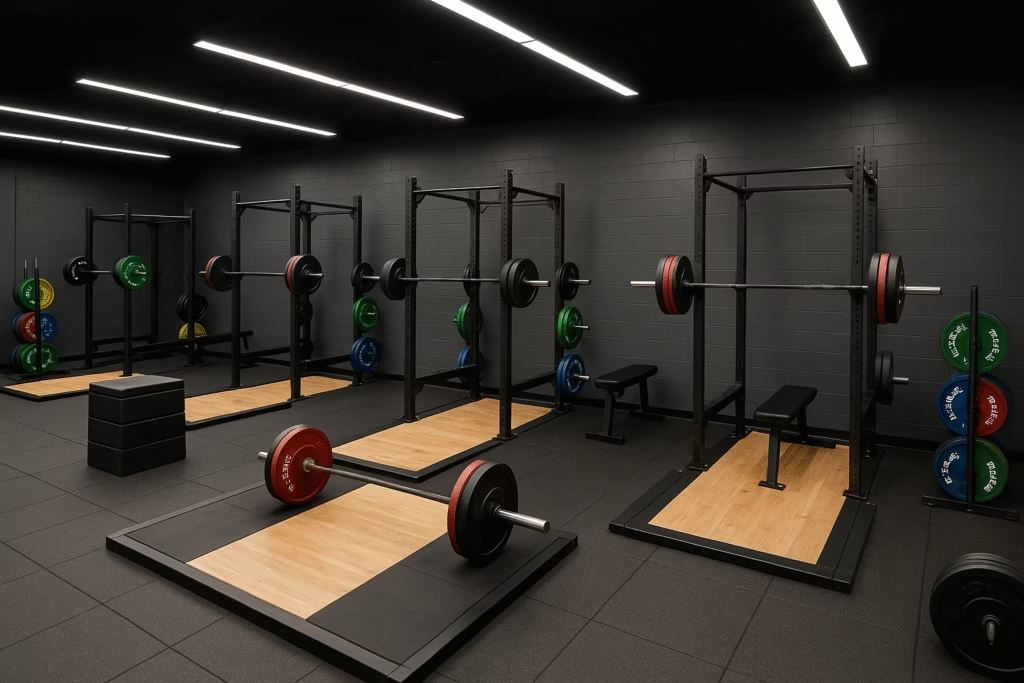
Injury statistics in powerlifting:
- Injury rate: 1-5.8 injuries per 1000 hours of training
- Most common time: During competition or max effort training
- Recovery time: 2-8 weeks for minor injuries, 3-6 months for major ones
- Reinjury rate: 15-25% within the first year
Training variables that reduce injury risk:
- Proper warm-up: Reduces injury risk by 35-50%
- Progressive overload: 2.5-5lb increases weekly maximum
- Adequate sleep: Less than 6 hours increases injury risk by 70%
- Proper nutrition: Adequate protein reduces recovery time by 20-30%
Your 30-Day Injury Prevention Action Plan
Week 1-2: Assessment and Foundation
- Film all three main lifts from multiple angles
- Complete movement screens (overhead squat, single-leg balance)
- Establish baseline measurements (flexibility, strength)
- Begin daily 10-minute mobility routine
Week 3-4: Implementation and Refinement
- Address top 2 movement limitations identified
- Reduce training intensity by 10% to focus on form
- Add specific accessory exercises for weak areas
- Track sleep, nutrition, and recovery metrics
Beyond 30 days: Maintenance and Growth
- Monthly form video analysis
- Quarterly assessment with qualified professional
- Seasonal periodization planning
- Continuous education about safe training practices
The Bottom Line: Consistency Beats Intensity
The strongest powerlifters aren’t those who can lift the most weight once – they’re the ones who can lift heavy weights consistently for years without major injuries. Every week you stay healthy is a week you can keep getting stronger.
Remember: An ounce of prevention is worth a pound of PRs. Invest in your movement quality, listen to your body, and prioritize longevity over short-term gains. Your 50-year-old self will thank you for the discipline you show today.
Start today: Pick one prevention strategy from this guide and implement it this week. Small, consistent actions compound into big results over time.
Ready to lift smarter and stronger? Your injury-free powerlifting journey starts with your very next training session.
FAQs
Q: How long do powerlifting injuries take to heal?
A: Minor injuries usually heal in 2-8 weeks, while major ones can take 3-6 months or more. Early treatment and not training through pain speeds recovery.
Q: What’s the difference between soreness and injury?
A: Soreness is dull and achy, improves with movement, peaks 24-48 hours later, and affects both sides equally. Injury pain is sharp, worsens with movement, happens immediately or gets worse over time, and is often one-sided.
Q: Why do my knees hurt when squatting?
A: Usually from knees caving inward, tight ankles forcing knees forward, weak glutes, squatting too deep for your mobility, or previous knee problems.
Q: How do I know if my form is good?
A: You can do the movement perfectly with bodyweight, no pain during or after lifting, technique stays consistent when tired, video analysis looks good, and you understand the key points.
Q: How often should I test my max?
A: Beginners every 8-12 weeks, intermediate every 6-8 weeks, advanced every 4-6 weeks or before competition. Focus more on consistent progress than max testing.
